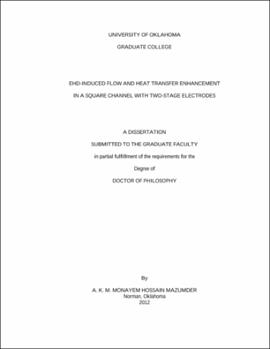| dc.contributor.advisor | Lai, Feng C | |
| dc.creator | Mazumder, A. K. M. Monayem Hossain | |
| dc.date.accessioned | 2019-04-27T21:38:04Z | |
| dc.date.available | 2019-04-27T21:38:04Z | |
| dc.date.issued | 2012 | |
| dc.identifier | 993707002042 | |
| dc.identifier.uri | https://hdl.handle.net/11244/319218 | |
| dc.description.abstract | The generation of a fluid flow and consequent effects on heat transfer enhancement within a square channel by electrohydrodynamic (EHD) gas pump are examined using both experimental and numerical methods. Experiments are conducted first to provide important information for the computing of electric field in the numerical study. | |
| dc.description.abstract | In this study, flow field inside a square channel with a two-stage EHD gas pump is first investigated via experimentation. Electrode pins are flush mounted on the channel walls and charged with a high voltage. The study has been performed for the EHD gas pump with three grounded electrode configurations: 0.5-inch, 1-inch, and 2-inch wide at top with 0.5-inch wide at bottom of two-stage unit. The EHD gas pump with 28 emitting electrodes in each stage is tested for a wide range of operating voltages starting from the corona onset up to 28 kV for further improvement in its performance over a single-stage one. Both corona current and corona wind velocity inside the channel are measured for operations using positive corona discharges. The performance of the EHD gas pump is then evaluated against that of conventional cooling fans used in personal computers. The experimental results provide important insights for the optimal design of an EHD gas pump. | |
| dc.description.abstract | Based on the experimental study, a numerical model is developed. The three-dimensional governing equations for the electric, flow, and temperature fields are solved using the finite volume method. Corona-driven (i.e. EHD-Induced) flow is calculated first, and its results are compared with the experimental data to validate the computational code. The numerical results enable vivid flow visualizations inside the channel, providing a great understanding of the development of the induced flow. | |
| dc.description.abstract | The influence of electric field on the flow and temperature fields is also investigated with forced convection. Numerical simulations are performed for the EHD gas pump with all three electrode configurations at various applied voltages and a wide range of Reynolds numbers. The heat transfer enhancement and thermal hydraulic performance are then evaluated. To achieve the maximum enhancement in heat transfer, the emitting electrodes of the corona wind generator are flush mounted on the channel walls so that the corona wind produced can directly perturb the boundary layer. The results of the numerical study show that EHD technique has a great potential for many engineering applications, particularly for thermal management. | |
| dc.format.extent | 210 pages | |
| dc.format.medium | application.pdf | |
| dc.language | en_US | |
| dc.relation.requires | Adobe Acrobat Reader | |
| dc.subject | Electrohydrodynamics | |
| dc.subject | Heat--Transmission | |
| dc.subject | Fluid mechanics | |
| dc.subject | Heat--Convection | |
| dc.title | EHD-INDUCED FLOW AND HEAT TRANSFER ENHANCEMENT IN A SQUARE CHANNEL WITH TWO-STAGE ELECTRODES | |
| dc.type | text | |
| dc.type | document | |
| dc.thesis.degree | Ph.D. | |
| ou.group | College of Engineering::School of Aerospace and Mechanical Engineering | |
